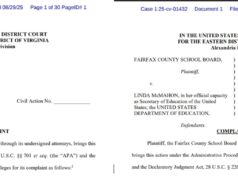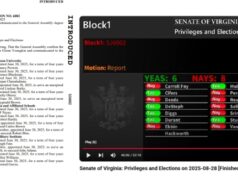by Cindy
While schools have hired police–to provide security and ostensibly to give students an opportunity to engage in positive interactions with law enforcement while young–since around the 1950s, this practice took on a more routine and formal structure in Virginia in 1999. That year the General Assembly created the School Resource Officer Incentive Grants Fund, to “award matching grants to school boards to employ uniformed school resource officers in secondary schools within the relevant school division. Such school resource officers shall be certified law-enforcement officers and shall be employed to help ensure safety and to prevent violence in schools,” subject to guidelines they might issue.
But the presence of officers in schools has increased the tendency for schools to refer behavior and discipline problems that had previously been handled by school counselors or administrators and families to law enforcement instead. The Center for Public Integrity reported in 2015 that Virginia schools referred students to law enforcement at a rate of 16 times per thousand students–three time the national average. Worse, the presence of law enforcement officers in schools disproportionately affected students with disabilities (referred 33 times per thousand students) and Black students (25 times per thousand students).
Shocking stories made news headlines, like the 2014 handcuffing and shackling of a four-year-old student with ADHD by a sheriff’s deputy working at the school; or the 2014 arrest of an 11-year-old child with autism, who was handcuffed, driven to jail, and charged with disorderly conduct and assault against a law enforcement officer (a felony in Virginia, even when the officer is uninjured).
Since then, Virginia has taken a number of steps in an attempt to improve the school resource officer system to reduce its effect on the school to prison pipeline. In 2015, Governor McAuliffe created the first-ever Children’s Cabinet; and launched the “Classrooms not Courtrooms” initiative, a multi-agency plan to reduce student referrals to law enforcement, reduce suspensions and expulsions, and in particular, to address the disparate impact referrals have on African-American students and students with disabilities.
To inform the work of this initiative, Virginia Tech conducted follow-up research on SROs in early 2017. They found that while the previously-reported referral rates were grossly overstated, the disparate impacts on Black students and those with disabilities was accurate—both for referrals to law enforcement as well as suspensions and expulsions. Additionally, they found that the presence of SROs in middle schools and high schools significantly increase the rate of referral for non-violent offenses.
The Administration then developed a model Memorandum of Understanding (MOU) to be used by school districts receiving grant funding through the SRO Incentive Grants Fund, to ensure that best practices were being used statewide. This MOU limited the scope of SROs and defined their roles as threefold: 1) to prevent crime and promote safety, including reducing “student engagement with the juvenile justice system” and diverting students from the courts; 2) a law-related educator; 3) an informal mentor and role model.
“School administrators and teachers are responsible for school discipline. Although SROs are expected to be familiar with the school division code of student conduct, the rules of individual schools, and their application in day-to-day practice, SROs should not be involved with the enforcement of school rules or disciplinary infractions that are not violations of law.
Consequences of student misconduct should be effective, developmentally appropriate, and fair. Interventions and school sanctions should help students learn from their mistakes and address root causes of misconduct. School administrators will consider alternatives to suspensions and law enforcement officials will consider alternatives to referrals to juvenile court services and arrests for student violations of law.
The SLEP shall operate in a manner to ensure children with disabilities receive appropriate behavioral interventions and supports.”
There is very limited data so far on whether these changes to the SRO program have eliminated the over-policing of students or the disparate impact of law enforcement referrals and suspensions and expulsions. There is at most one year of new data to look at. Additionally, recent legislative efforts have exempted students at school from disorderly conduct laws, one of the main non-violent law enforcement referrals; eliminated the requirement that school administrators report misdemeanors to law enforcement; and mandatory de-escalation and implicit bias training for SROs. These changes won’t yet be reflected in data.
Nevertheless, some localities such as Charlottesville and Fairfax County want to scrap SROs entirely in their school districts, arguing that the MOU is not in the interests of their students, and that the matching money the school system pays could be better spent on a model focusing on mental health and community-building. More broadly, eliminating SROs statewide could free up resources to spend on school counselors, something that was an important feature in the 2020 budget, and was delayed by COVID-19 cuts.
In an Arlington Young Democrats Criminal Justice Town Hall a few weeks ago, the subject of SROs came up, and the discussion (at the one hour and seven minute mark) between Senators Barbara Favola and Jennifer McClellan and Delegate Patrick Hope conveniently summed up where the status of the SRO program currently stands:
While it seems that much work has been put in over the past few years in an attempt to address the weaknesses and biases within the SRO program, and we have yet to fully determine whether those changes have been effective, we also don’t have much evidence that SROs are successful at the objectives they purport to have—to keep students safer. They do not seem to be able to successfully intervene to stop school shootings. And greater spending on SROs is not related to reduced incidence of violent crimes. While more data would be useful, and in particular, new data following the numerous policy changes made recently, we should remain open to the idea that the SRO may turn out to be a concept best scrapped and left on the drawing room floor.














![Monday News: Trump’s Lunacy Pushes China, Russia, India, etc. Together; “Happy Labor Day. Donald Trump and Elon Musk Are Screwing Workers.”; “Where is the [media’s] intense focus on Trump’s failing health?”; ““Trump says he is not a dictator. Isn’t he?”](https://bluevirginia.us/wp-content/uploads/2025/09/montage0901-100x75.jpg)